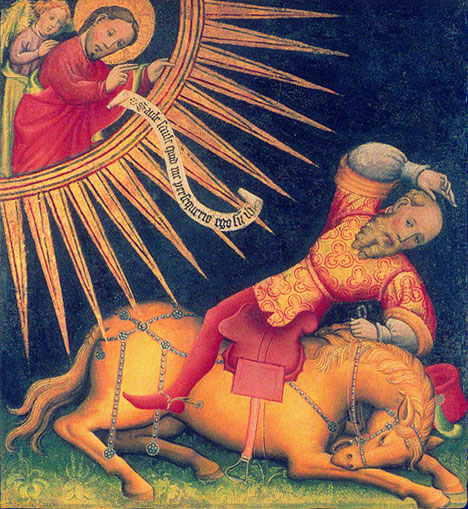Galatians – 2
 Paul’s Exodus
Paul’s Exodus
To highlight what Paul is doing in the shape of his letter to the Galatians, I’ve updated the subtitle of yesterday’s post to Paul’s Genesis. The second cycle is thus Paul’s wilderness journey, concerning the “veil” of unknowing that remained between Paul and the apostles, and also between Paul and the churches in Judea. The “packaging” of his argument in the structure of the history of Israel is interesting. Like the birth of Israel as a nation under Moses, Paul’s ministry was not a product of the earlier apostles: his commission came directly from Christ. There is also the undertone that he has re-enacted the pattern of “prophetic” training in the wilderness, which was always a preparation of an “Israel” to minister to the nations.
CREATION - From the Source
When the Covenant structure of this stanza is identified, every line takes on extra significance. Paul is God’s prophetic mouth in line 1, the Gentile brothers are a new Israel, and the gospel itself (euangelisthen) is the “angel” at the centre. Paul’s proclamation is actually Covenant Sanctions (blessings and curses) for Israel in line 4, and his use of kata (down from, according to) in line 5 implies that this message is true Shekinah. (The false prophet would later call down false fire from heaven, like the priests of Baal.)
DIVISION - The Veil is Torn
Architecturally-speaking, this step is the Tabernacle’s Veil, and also circumcision. Here, the Mosaic Veil is taken away. Paul actually reverses the Covenant pattern, which includes the order of the threefold Ethics: Law given, Law opened, Law received. He has not received this message from Israel but from God. The “revelation” in this pattern corresponds to the Veil opened on the Day of Atonement (Sanction/Oath). The structure implies that Paul has access to the Most Holy Place. (On the correspondence of circumcision with revelation, see Circumcision and Apocalypse.)
ASCENSION - The Unworthy Man
Ascension has to do with the Levitical priesthood, the firstfruits and external Law (the stoicheia). It is a “preliminary” filling (as the grain and fruit on Day 3). Here, the “filling up” is the flesh and blood of the saints (which supports Jordan’s interpretation of Revelation 14).
TESTING - The Judaizer
Judaism appears in the same place here as in stanza 3, as does the idea of “filling” at the centre. Paul was filled with darkness but he believed it was light. Stanza 3 was about the sacrificial knife; stanza 4 is Judaism’s “strange fire” post-Pentecost. In terms of the Ten Words, this is murder and “harlotry.”
MATURITY - The Prophet
The theme at “Trumpets” is resurrection, the Bridal Body, and witness to the nations. The festal structure implies that Paul is now a true Israelite, carrying out the mission to the nations which was the very purpose of the original call of Abraham, and the miraculous birth of Isaac. (Note that Paul also hints at language from Psalm 22 and Jeremiah 1.)
CONQUEST- A New Land
At the “Day of Coverings” (stanza 6), Paul is away from Jerusalem. In fact, he is the scapegoat (line 6). He himself is carrying the sins of Israel into the wilderness, as prophets do. Analysis of the structure also reveals why Paul uses the phrase “flesh and blood” (which gets glossed into “anyone” in the ESV). He is not referring to humans in general, but to the Jews. It seems he has placed his thesis, Jerusalem, at the centre as the city of the kings.
GLORIFICATION – A New Covenant
The final stanza is expanded “fractally” into its own complete pattern. It begins with a two week rest with Peter in Jerusalem, which is again at the centre, this time presumably as the city of kings at the centre of this stanza of peace. The fifteenth day leads to the “Passover” stanza.
Again, a reference to the Jewish Christian leaders and a “veil.” I’m not sure why James is placed at Sanctions. Perhaps because James is the same name as Jacob, who saw God face to face (Genesis 32:30).
Noting the structure makes sense of this strange inclusion. Instead of a serpent lying at the centre of the pattern, we have Paul telling the truth about the New Covenant.
At Sanctions, Paul is a mixture of curses and blessings. Concerning the truth of his conversion, the veil was still closed.
Finally, the saints hear the truth, and the true glory of God shines in His new temple.

























